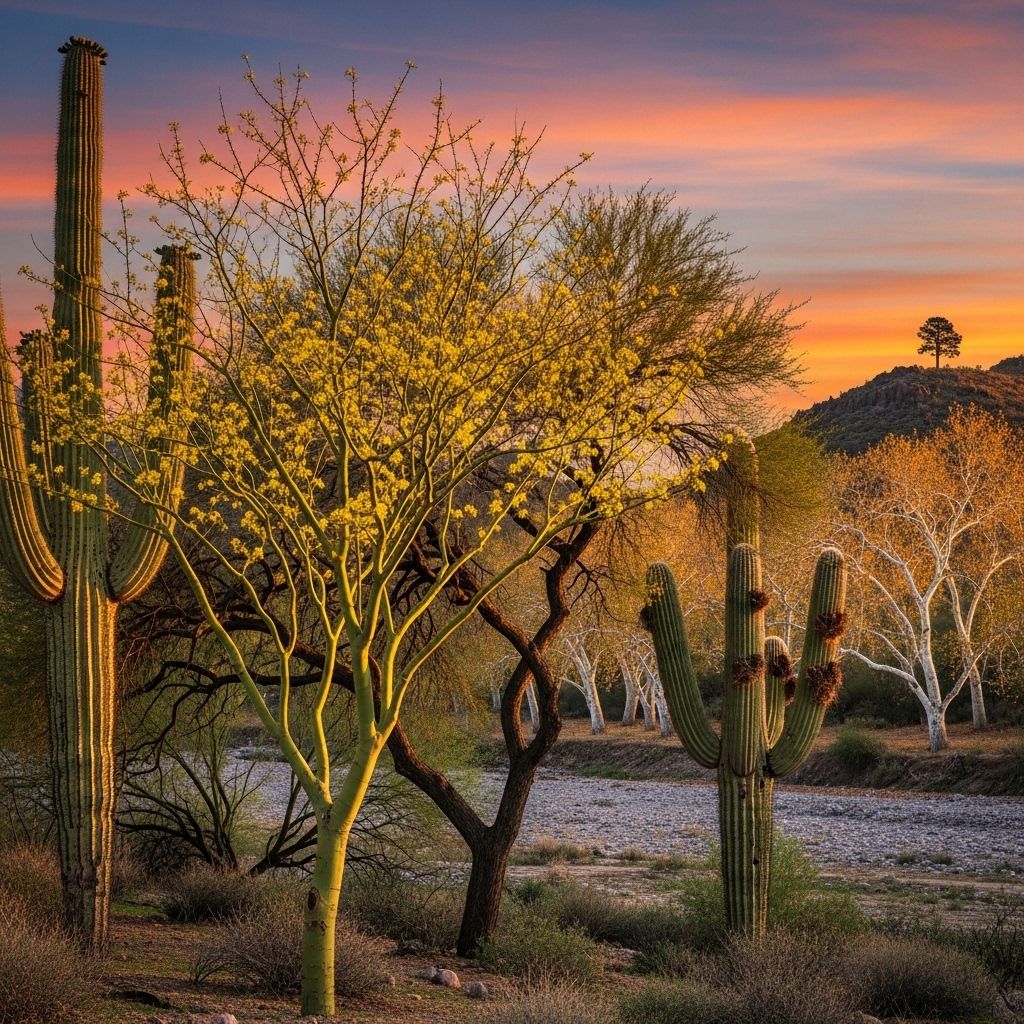Arizona Trees: Best Species & Care Tips for Every Climate
Climate-smart planting and pruning strategies ensure resilient, drought-ready landscapes.

Image: HearthJunction Design Team
Arizona’s unique and diverse climates—from scorching deserts to cooler uplands—offer a wide range of opportunities for growing beautiful and resilient trees. Whether you’re planning a new landscape or looking to upgrade an existing garden, understanding the best tree species for each Arizona climate zone, along with essential care tips, is key to success. This guide covers everything from selecting the right trees to planting, watering, pruning, and troubleshooting common issues.
Why Choose the Right Trees for Arizona?
Arizona’s climate can be harsh, with intense sun, low humidity, and temperature extremes. Choosing trees that are adapted to these conditions not only ensures better survival and growth but also reduces water usage and maintenance requirements. Native and well-adapted non-native trees provide shade, wildlife habitat, and beauty, while also contributing to a more sustainable landscape.
Popular Native Trees in Arizona
Native trees are well-suited to Arizona’s environment and require less water and care once established. Here are some of the most popular native tree species in Arizona:
- Velvet Mesquite (Prosopis velutina): A classic desert tree known for its drought tolerance and fine foliage.
- Desert Ironwood (Olneya tesota): Renowned for its longevity and attractive lavender-pink spring flowers.
- Blue Palo Verde (Parkinsonia florida): Famous for its green bark and bright yellow spring blooms.
- Foothills Palo Verde (Parkinsonia microphylla):
- Arizona Sycamore (Platanus wrightii): A larger native tree ideal for riparian areas and large landscapes.
- Desert Willow (Chilopsis linearis): Valued for its showy, trumpet-shaped flowers and drought tolerance.
- Alligator Juniper (Juniperus deppeana): A hardy evergreen found in higher elevation areas.
- Emory Oak (Quercus emoryi): A medium-sized oak native to southern Arizona.
Non-Native Trees That Thrive in Arizona
While native trees are ideal for low-maintenance landscapes, some non-native species can also thrive if given proper care and the right conditions. Popular choices include:
- Olive (Olea europaea): Excellent for Mediterranean-style gardens and adapted to hot, dry climates.
- Bottle Tree (Brachychiton): Unique appearance and drought tolerance make it a striking landscape feature.
- California Pepper (Schinus molle): Provides quick shade and feathery foliage, though it can be invasive in some areas.
- Eucalyptus (Eucalyptus spp.): Fast-growing and aromatic, but requires regular pruning and can be prone to pests.
- Acacia (Acacia spp.): Many species are well-suited to Arizona’s climate, offering feathery leaves and yellow flowers.
Arizona Climate Zones and Tree Selection
Arizona’s varied climate zones require careful consideration when selecting trees:
| Climate Zone | Elevation | Recommended Trees |
|---|---|---|
| Low Desert | Below 1,500 ft | Mesquite, Palo Verde, Ironwood, Desert Willow |
| Mid- to High-Desert | 1,500–4,500 ft | Desert Willow, Acacia, Palo Verde, Olive |
| Intermediate | 4,500–6,000 ft | Arizona Sycamore, Arizona Walnut, Alligator Juniper, Emory Oak |
| Mountains | Above 6,000 ft | Ponderosa Pine, Douglas Fir, Rocky Mountain Maple |
Tree Care Tips for Arizona Landscapes
Proper care is essential for tree health and longevity, especially in Arizona’s challenging climate. Follow these guidelines for best results:
- Watering: Young trees need regular watering to establish roots. Once established, most natives require little supplemental irrigation.
- Soil Preparation: Amend heavy clay or rocky soils with organic matter to improve drainage and root development.
- Mulching: Apply a 2–4 inch layer of mulch around the base (but not touching the trunk) to retain moisture and regulate soil temperature.
- Pruning: Prune during late winter or early spring to remove dead or damaged branches and promote healthy growth.
- Pest and Disease Control: Monitor for pests like borers and scale, and treat promptly if detected.
Landscaping with Arizona Trees
Incorporating trees into your Arizona landscape provides shade, reduces heat, and enhances outdoor living spaces. Consider these design tips:
- Shade Trees for Patios: Plant mesquites, palo verdes, or sycamores to create natural shade for patios and outdoor seating areas.
- Wildlife Habitat: Native trees like desert willow and ironwood attract birds, pollinators, and other wildlife.
- Water-Wise Design: Group trees with similar water needs to maximize efficiency and reduce maintenance.
- Screen and Privacy: Use evergreen species such as junipers or olives to create privacy screens or windbreaks.
Challenges of Growing Trees in Arizona
Despite the many benefits, growing trees in Arizona comes with challenges:
- Heat Stress: High temperatures can scorch leaves and stress young trees. Provide afternoon shade and adequate water during heat waves.
- Limited Water: Drought and water restrictions require careful water management. Use efficient irrigation systems like drip or soaker hoses.
- Soil Issues: Alkaline, compacted, or rocky soils can hinder root growth. Test soil and amend as needed.
- Pests and Diseases: Watch for borers, scale insects, and fungal diseases. Regular monitoring and prompt treatment are essential.
Frequently Asked Questions (FAQs)
Q: What are the best trees to plant in the Phoenix area?
A: In the Phoenix valley, consider mesquites, palo verdes, desert willow, ironwood, and olive trees. These species are heat- and drought-tolerant and well-adapted to the region’s conditions.
Q: How often should I water newly planted trees in Arizona?
A: Newly planted trees typically need thorough watering two to three times per week for the first few months. Gradually reduce frequency as roots establish, eventually switching to deep, infrequent watering.
Q: Can I grow citrus trees in Arizona?
A: Yes, citrus trees like oranges, lemons, and grapefruits thrive in the low desert, provided they receive enough water and protection from frost in colder months.
Q: What is the best time of year to plant trees in Arizona?
A: The best times to plant are late fall and early spring, when temperatures are milder and trees have time to establish roots before summer heat or winter cold.
Q: Are there any trees I should avoid planting in Arizona?
A: Avoid species that require consistently moist soil or are prone to heat stress, such as certain maples and some non-native fruit trees. Invasive species like salt cedar (Tamarix) should also be avoided.
Conclusion
Selecting and caring for the right trees in Arizona can transform your landscape, providing shade, beauty, and ecological benefits. By choosing native and well-adapted species, following best practices for planting and maintenance, and addressing common challenges, you can enjoy a thriving, water-wise garden that enhances your outdoor environment year-round.
References
Read full bio of Shinta












